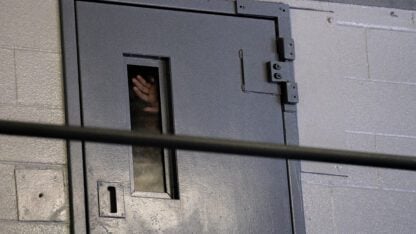CARE Officials Help Syrian Refugees in Amman, Jordan: Part 2


[Note: this story was originally broadcast on Tuesday morning, October 1, 2013]
Since the conflict in Syria began, nearly 2-million Syrians have fled to neighboring countries.
And that includes Jordan.
The country of Jordan borders the southern region of Syria.
And it’s estimated nearly a half-million Syrians are now in Jordan.
Mostly all are receiving displacement help from humanitarian organizations such as Atlanta based-CARE.
WABE’s Rose Scott traveled throughout Jordan with CARE representatives who are working with the refugees.
Listen to Part 2 of the series.
It’s a late afternoon in Amman, Jordan.
Along this busy road are street vendors and numerous markets.
Everything is for sale; sneakers, women’s dresses and delicacies native to the country.
Children are returning from school.
CARE officials are headed to see a Syrian refugee who now lives in Amman.
The 25-minute ride is enough time for Zeinab to discuss life in Amman for many of the refugees.
Zeinab, a Jordanian, is the admin officer in CARE international’s Syrian refugee program.
Zeinab is Jordanian.
We began our conversation with why there are more women who come to the refugee center.
“So many women left there husband behind or we have so many women also who lost their men in the war there.”
Jordan now has 4 refugee centers spread throughout the country.
And for many of the refugees the number one priority is finding shelter.
There have been horrific stories about life in a refugee camp.
That camp is not operated by CARE.
So the centers are the frontline to getting an apartment.
And that means living in Amman.
But native Jordanians already in that area are also trying to make ends meet.
Many are poor themselves.
It’s even rougher for Syrian refugee men who desperately want to work.
Again CARE worker Zenib.
In Jordan, the government requires all Syrian refugee men to purchase a work permit.
If a market owner or factory has Syrians working without the permit, the business faces a fine.
A work permit cost five hundred Jordanian dollars.
That’s equals to just over seven-hundred in the U.S currency.
The refugee we’re visiting lives in a crowded market section of Amman.
We walked up four flights of stairs to get to Maryam’s place.
The petite woman with brown hair was able to find this four-room flat above a fabric store.
She was referred to the CARE Amman center by the Italian hospital.
According to CARE, Maryam suffers from a mass in her brain and requires medicine that costs one-hundred and fifty Jordanian dollars a month, which is nearly $212.00 dollars in U.S. currency.
She’s just returned from picking up her daughter from school.
Zenib translates the question every Syrian refugee often gets.
WABE: “How often she thinks about her home Syria?
Maryam to Zenib: “She says she doesn’t have home. It’s gone and her husband has been killed as well.”
Maryam has asked not to continue talking about her late husband in front of their nine-year old daughter.
Maryam also has a 21-year old son, but he doesn’t live with his mother and little sister.
He lives in Jordan.
Maryam says he cannot climb the four flights of stairs because of beatings at the hands of the Syrian police.
His legs were injured and “he can’t get up the stairs”, says Maryam to Zenib.
As the interview continues, Maryam becomes more at ease and reveals that one of her sister’s sons came just a day ago and he’s hiding in one of the rooms.
He still has family in Syria and thinks the presence of the media could mean problems.
But after promising not to take pictures and only use his first name, Maryam’s nephew limps into the room and sits down on one of the brown floor cushions.
He grabs a cigarette and Maryam offers coffee before he tells his story.
9(MDAxODM0MDY4MDEyMTY4NDA3MzI3YjkzMw004))





